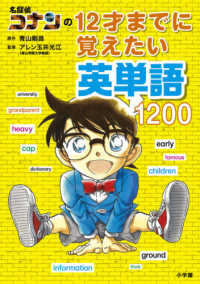- ホーム
- > 洋書
- > 英文書
- > Religion / Ethics
Full Description
Ancient Jewish writings combine interpretive narratives of Israel's sacred history with legal prescriptions for a divinely ordered way of life. Two ancient Jewish societies have left us extensive textual corpora preserving interpenetrating legal and narrative interpretive teachings: the sectarian community of the Dead Sea Scrolls and the sage-disciple circles of the early Rabbis. This book comprises studies that explore specific aspects of the interplay of interpretative, narrative, and legal rhetoric with an eye to pedagogic function and social formation for each of these communities and for both of them in comparison. It addresses questions of how best to approach these writings for purposes of historical retrieval and reconstruction by recognizing the inseparability of literary-rhetorical textual analysis and a non-reductive historiography.
Contents
I. INTRODUCTION/RETROSPECTIVE
1: Introduction: Of Legal Fictions and Narrative Worlds
2: Nomos and Narrative Before "Nomos and Narrative"
II. DEAD SEA SCROLLS
3: Interpretive Authority in the Studying Community at Qumran
4: To Whom It May Concern: Miqṣat Maʿaśe Ha-Torah (4QMMT) and Its Addressee(s)"
5: Rhetoric and Hermeneutics in 4QMMT: The Case of the Blessings and Curses
III. COMPARATIVE: DEAD SEA SCROLLS AND RABBINIC LITERATURE
6: The Dead Sea Scrolls and Rabbinic Judaism after Sixty (Plus) Years: Retrospect and Prospect
7: Qumran Yaḥad and Rabbinic Ḥavurah: A Comparison Revisited
8: Looking for Legal Midrash at Qumran
9: Looking for Narrative Midrash at Qumran
10: Shifting from Priestly to Non-Priestly Legal Authority: A Comparison of the Damascus Document and the Midrash Sifra
11: Deuteronomy and Polity in the Early History of Jewish Interpretation
12: Ancient Jewish Law and Narrative in Comparative Perspective: The Damascus Document and the Mishnah
13: Theory, Practice, and Polemic in Ancient Jewish Calendars
14: "The Torah of the King" (Deut 17:14-20) in the Temple Scroll and Early Rabbinic Law
IV. RABBINIC LITERATURE
15: Priests, Kings, and Patriarchs: Yerushalmi Sanhedrin in its Exegetical and Cultural Settings
16: Navigating the Anomalous: Non-Jews at the Intersection of Early Rabbinic Law and Narrative
17: Literary Composition and Oral Performance in Early Midrashim
18: Rewritten Bible and Rabbinic Midrash as Commentary
19: Rabbinic Midrash and Ancient Jewish Biblical Interpretation
20: Rabbinic Polysemy and Pluralism Revisited: Between Praxis and Thematization
21: Moses and the Commandments: Can Hermeneutics, History, and Rhetoric be Disentangled?
22: Hearing and Seeing at Sinai: Interpretive Trajectories
23: The Temple as a Jewish Identity Marker Pre- and Post-70 C.E.: With Particular Attention to the Holy Vessels in Rabbinic Memory and Imagination
24: Local Jewish Leadership in Roman Palestine: The Case of the Parnas in Early Rabbinic Sources in Light of Extra-Rabbinic Evidence
V: AFTERWORD/PROSPECTIVE
25: Afterword: Between History and its Redemption
Index of Ancient Authors and Sources
Index of Modern Authors
Subject Index






